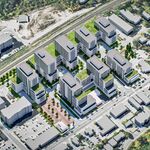jaycola, the answer goes to the heart of why we preserve things. If your answer to that question is that we are out to preserve only the best architecture from an aesthetic point of view, or to preserve the best examples of urban planning, this might not be saved. If your answer is that preservation is to retain some indication of our collective past as reflected in its built form, then it might be worth saving some instances of this type of building. I tend to prefer the former to the latter, because questions of architectural merit tend to fluctuate over time, as do examples of what is held up to be good urban planning. For me, ideally, heritage preservation would seek to retain some examples from a wide spectrum of building types, styles, and uses, and the best approach is a humble one. Though it may seem impossible to us to imagine that certain building types or styles have anything to tell us, the best course of action is to preserve from a fairly wide array of samples. There's a good analogy with preservation of species - we ought not concentrate on just the cute ones or the ones that serve some obvious or commercial purpose, but we might acknowledge that, even if we don't see the value in something, it might be best to have it there, waiting to give us a lesson later on.
For the record, this is the "official" answer to your question, somewhat abridged:
A building, structure or site may be considered important for a variety of reasons. It may have architectural value or it may relate to a significant person, an important event in the history of the city or a critical time in the development of one of its neighbourhoods. A building may be well crafted or represent a characteristic of the community. A building does not have to be "old" to be an important heritage property.










